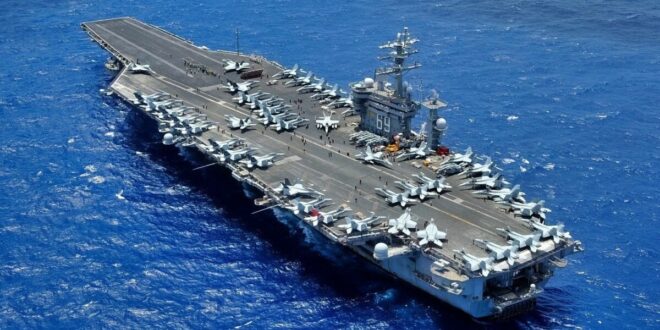No defensive umbrella is perfect. It is plausible that the Houthis could sneak an antiship cruise or ballistic missile or drone past aircraft carrier USS Eisenhower’s escorts and the carrier’s own point defenses. But sinking an aircraft carrier is another matter.
Summary and Key Points: Rumors that Houthi militiamen have sunk or driven off the USS Dwight D. Eisenhower are false. Despite Houthi claims and some damage to merchant vessels, the U.S. aircraft carrier remains intact and operational, as documented by Western media.
While it’s unlikely that the Houthis possess the firepower to sink a Nimitz- or Gerald Ford-class carrier, they could potentially damage it with a well-aimed missile or drone, achieving a “mission kill” and a propaganda victory.
-The U.S. Navy must prepare a strong counternarrative to mitigate any political impact from such an event.
USS Dwight D. Eisenhower Remains Unscathed Amid Houthi Claims
Rumors of USS Dwight D. Eisenhower’s death have been grossly exaggerated. Houthi militiamen, abetted by their boosters within the wretched hive of scum and villainy, claim to have sunk or driven off Eisenhower, the nuclear-powered aircraft carrier (CVN) that anchors the multinational task force defending freedom of transit in the Red Sea. The carrier’s fighter/attack jets have swatted down Houthi antiship missiles and drones while striking shore sites that target mercantile and naval shipping. Western press outlets have kindly documented that the ship remains afloat and in good working order.
So Houthi claims to have mounted a successful assault on the flattop are bunk—this time around. But is the carrier’s invincibility one of those things that’s true until it’s not? It bears pondering whether a missile-armed substate combatant could sink a U.S. Navy carrier even though none has pulled it off to date.
It’s doubtful in the extreme that the Houthis, scarcely a great power, could muster the volume of fire needed to send a Nimitz- or Gerald Ford-class CVN to Davy Jones’ locker. As the past few months of fighting have shown, puncturing a U.S. battle group’s defenses with intermittent missile or drone attacks is far from easy. The Houthis have managed to damage or incapacitate unarmed merchantmen, but they have scored no hits on ships of war. To all appearances their arsenal is too meager to deliver volleys of munitions in sufficient numbers to bewilder, saturate, and overpower U.S. defenses.
That being said, no defensive umbrella is perfect. It is plausible that the Houthis could sneak an antiship cruise or ballistic missile or drone past Eisenhower’s escorts and the carrier’s own point defenses. (They got close to one American combatant.) That’s because the physics of shipboard air defense is forbidding. Smiting down a bullet hurtling toward you is just plain hard—especially if you depend on another bullet to do the smiting.
In other words, Houthi rocketeers could land a blow. But would it be a mortal blow?
Doubtful. Much like battleships of old, the vital innards of American supercarriers are sheathed in stout armor, tough for ordnance to penetrate. These are not eggshells. Almost two decades ago, in fact, it took weeks of pounding away at USS America—a decommissioned hulk bearing no crew and with no capacity to defend itself—to send the ship to the bottom. That’s rugged construction. It strains credulity to imagine Yemeni militants’ replicating a feat of that magnitude against a fully crewed carrier with Aegis guided-missile destroyers or cruisers riding shotgun nearby.
Still, Houthis might accomplish the next best thing to mortally wounding a carrier. They could reap a propaganda coup simply by landing a hit on Eisenhower or some successor.
A single well-aimed missile or drone could demolish fragile, exposed sensors, communications gear, or command-and-control suites on the carrier’s island structure, or tower, knocking the ship out of the fight until the crew or a shipyard could effect repairs. Or a munition could play havoc with aircraft sitting on the flight deck, subtracting damaged or destroyed warplanes from the ship’s combat power while obstructing launch and recovery operations.
That would suffice for Houthi purposes. In navy jargon an attack that deprives a unit of the ability to do its job is a “mission kill.” A mission kill on a CVN would defeat the ship, taking its air wing—its striking arm—out of action. And possibly out of the Middle East. Potentially for an extended interval.
Houthis can have victory without destruction.
Think about the political impact of even a brief mission kill—especially if Houthis managed to record images of a burning supercarrier, presumably by deploying surveillance drones to the scene. Houthi leaders could burnish their martial reputation to a high gloss if the provenance of the imagery were impeccable—unlike the doctored video underwriting their tall tale of a sunk or damaged Eisenhower. Houthis could rightly claim to have struck a blow at the vaunted U.S. Navy carrier fleet. And if the carrier then had to withdraw for repairs, the militants could plausibly claim to have sent the pride of the Navy scurrying from regional waters.
Prestige—and recruitment to the rebel cause—would flourish.
Such a stratagem would come straight out of the Yemeni playbook. Think about the October 2000 terrorist bombing against the Arleigh Burke-class destroyer USS Cole in the Yemeni seaport of Aden. Photographs of a U.S. Navy ship of the line with a near-fatal 40-foot crater in its sideshocked Middle East and Western capitals (and jumpstarted your humble scribe’s career writing for newspapers) while rousing joy among militant groups. It could work again.

So no, Houthis will not sink a nuclear-powered aircraft carrier. But they could parley even a minor triumph at arms into major political gains. It behooves U.S. Navy public-affairs folk to think ahead now about what kind of counternarrative would deny the militants their propaganda windfall—and recoup the Navy’s good name.
Forewarned is forearmed.
 Geostrategic Media Political Commentary, Analysis, Security, Defense
Geostrategic Media Political Commentary, Analysis, Security, Defense





